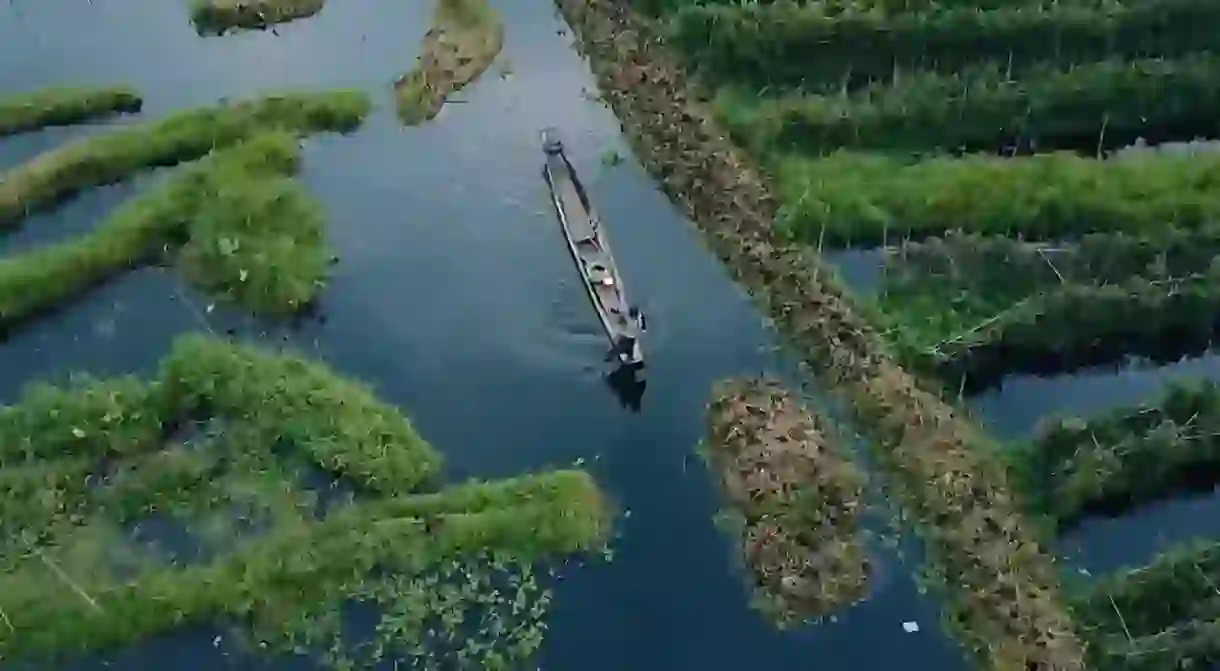Inle Lake: the Calmest Commute in the World

Inle Lake packs it in. This lake in Myanmar’s Shan Hills is home to fishermen, temples, caves, stilted houses, marshland and wildlife. Farms float on its surface, and hill tribes live around its shores. Yet, despite all this activity, it can be a tranquil place.
There are wide open stretches here, as well as narrow channels that lead between floating villages and lush vegetation.

At dawn, as the shoreline peeks out from the morning mist and fishermen row silently over the water, being here can feel like living in another world.
Inle Lake: the basics
Set in the Shan Hills in central Myanmar, Inle Lake is the country’s second largest lake, after Indawgyi Lake to the north. It’s 22km (14mi) long and 11km (7mi) wide, and is 880m (2,890ft) above sea level, meaning it’s cooler than Myanmar’s lowlands (you may need a blanket on a morning boat trip), and its beauty and range of activities have made it one of Myanmar’s biggest attractions.
There’s undoubted natural appeal to Inle Lake. Bobbing around on the water, you’ll see hills rising around you and verdant greenery. Carp are plentiful, and although Inle isn’t massive, it’s home to an impressive number of endemic species, with 20 types of snails and nine types of fish that you won’t see anywhere else.
But Inle is also about its people and the way they live with these waters. Most locals are Inthe, a Burmese people who have lived around the lake for centuries. Many are subsistence fishers and farmers, living on stilted bamboo huts on the lake and in villages on its shores. They plant vegetables on floating plots that can ride out any changes in the water level and rice in the paddy fields around the nutrient-rich lake.
The lake from the air
Dimitar Karanikolov got an unusual perspective on the lake by flying above, using a hot-air balloon and a drone to capture footage of dugouts moving through Inle’s waters. The London-based photographer and architect gives a lovely sense of the lake’s mix of tranquility and action, panning past quiet creeks and buzzing watery crossroads where boats meet and buildings cluster.
Karanikolov‘s travels around Myanmar, also known as Burma, took him to the capital, Yangon, plus temple-packed Bagan and busy Mandalay, and his pictures show the strange geometry of temples and waterways as seen from above, looking at once surreal and familiar.
Exploring Inle Lake
A classic way to experience the lake and its traditions is via a traditional rowing boat. Small boats are typically piloted by fishermen who stand up at the stern and use their leg – hooked around the oar – to row the boat. This distinctive style allows the fishermen to see ahead of them, across parts of the lake that would otherwise be obscured by its many reeds and floating plants. Women generally row in a more usual style, sitting cross-legged and using their arms to drive the oar through the water.
Tours also take place in motorised boats, which have the advantage of speed. A day on the lake can include several fascinating attractions. Lakeside villages include Thaung Thut, where lotus plants are made into exquisite textiles, Indein, where you can explore crumbling pagodas, and Nampan, which produces cigars and cheroots. Silversmiths and other craftspeople can be visited on the lake itself. Travelling to these places, through inlets shadowed by foliage and fringed by stunning white and gold stupas, is the best part of the trip for many visitors.
Off the water, you can cycle to the atmospheric, relic-packed Pindaya Caves and Mingalar Market, which sells clothes, handicrafts and food. A vineyard offers the chance to sample local wine and eat in a swish restaurant.
Inle Lake’s future
Inle Lake is a fascinating place to visit, and a trip here will stay with you for a long time. However, beneath its placid surface, challenges lurk. The rise in farming, forest clearance and tourism has resulted in increased pollution and siltier water – Inle’s fertility is being threatened, and some years have seen water levels get dangerously low. Choosing responsible tour operators and eco-friendly accommodation can help preserve this glorious lake for future generations.













